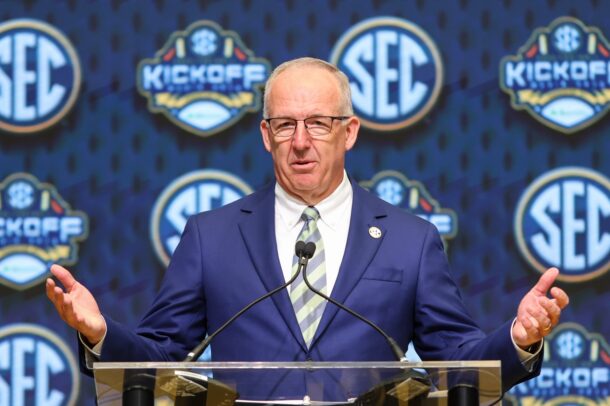
Some said that it would never happen, but finally, a 9-game conference schedule is indeed happening in the SEC.
For fans who want to see better football games, that news was a massive win. For fans of other conferences who insisted that the SEC was basically cheating by only playing 8 conference games, it was a bittersweet pill to swallow because now, that longtime gripe is dead. Still, it had to feel like a massive win for the sport as a whole.
Beginning in 2026, SEC teams will have 3 permanent rivals and 6 rotating opponents in conference play. Each team will still be required to play a Power Conference opponent in nonconference play, though the difference now is that means 10 Power Conference opponents per year are required in the SEC instead of 9.
It’s the type of decision that could have a much bigger say on the direction that college football is heading in the latter half of the 2020s and beyond. More competitive balance was achieved within the SEC, and we’ll see if that’s the case externally. The good news for the SEC is that it’ll get more revenue from ESPN at a time when college budgets are being tasked with more costs than ever.
So what does all of this mean? Let’s break it down with these 5 takeaways:
1. The timing was important because this was always about the Playoff
A day after we got the announcement that the selection committee would add a “record strength” metric, the SEC swiftly moved to a 9-game conference schedule. That’s not a coincidence. Read between the lines and you’ll realize that it’s what pushed SEC administrators over the finish line for a 9-game conference schedule. While the Big Ten was more focused on its TV contract than its Playoff chances when it moved from 8 conference games to 9 conference games in 2016, the SEC didn’t budge off of 8 games. That was rooted in the SEC’s belief that it would cause more harm than good for its Playoff chances, especially with how much the selection committee defaulted to records during the 4-team era, wherein a 2-loss team never made the field.
In other words, the selection committee vowed publicly to reward teams more for quality wins instead of dinging them for number of losses. We’ll see how that plays out. That was a major point of contention from the SEC after 9-3 Alabama, Ole Miss and South Carolina missed out on the Playoff while SMU (11-2) and Indiana (11-1) made the field.
This 9-game conference schedule confirms that there’s at least enough of a belief among SEC administrators that a 9-3 SEC team will be valued differently than another 11-1 Power Conference team. Make of that what you will.
What seems more imminent is that the Playoff will expand in 2026, which would align with the 9-game SEC schedule.
2. A 5+11 Playoff model in 2026? The ball is in the Big Ten’s court
As in, the 5 highest-ranked Power Conference champs and 11 at-large berths. The least radical of all the proposed expansion models could now be that much closer to happening. The Big Ten’s previous holdup to agree on a 5+11 Playoff model for a 16-team field was the SEC’s reluctance to go to a 9-game conference schedule. The Big Ten and SEC have control over what the next model will be, so one would assume this will push the 5+11 model over the finish line.
For those who were mortified at the Big Ten’s reported proposal for a 24- or 28-team Playoff, that would be a welcome sight. For those who were hoping for a stalemate that would keep the conferences at a 12-team Playoff — something that didn’t seem realistic with the financial urgency among administrators — Thursday’s news was a frustrating development.
So what could hold that up? As Ross Dellenger reported, the Big Ten has still been insistent on more automatic bids and less power with the selection committee. Why? A guaranteed financial floor. Of course, the Big Ten is now on an island with all other parties now in favor of the 5+11 model.
The deadline to decide on the 2026 Playoff format is Dec. 1, 2025. The clock is ticking for the Big Ten.
3. Nonconference rivalries were protected, but SEC teams like Alabama, Florida, Georgia and South Carolina have a new dilemma
All of them are set to play multiple Power Conference foes in nonconference play for the rest of the decade. In other words, that would be 11 Power Conference opponents in the regular season when the SEC only requires 10. Shoot, Georgia will play nothing but Power Conference opponents in 2027 if it doesn’t make any changes to a nonconference slate that’s set to include games at Florida State, vs. Louisville and at Georgia Tech. Florida also has 3 Power Conference teams lined up in nonconference play in 2028, and UGA has that same problem in 2030.
My guess? That won’t be the case. Even if the “record strength” metric favors playing more quality opponents, a team like Georgia would be pushing its depth to unnecessary lengths now that the conference schedule is at 9 games.
It’ll be interesting to see if any of those 4 teams cancel their additional Power Conference series. We also know that a handful of SEC teams are now overbooked with their nonconference slates, and they’ll have to buy out/reschedule at least 1 of those matchups.
Here are the 8 SEC teams who already have at least 1 year with 4 nonconference games scheduled:
- Arkansas: 2026
- Florida: 2028
- Georgia: 2026, 2030
- Kentucky: 2026, 2027, 2028
- LSU: 2029
- Mississippi State: 2026
- Mizzou: 2027, 2028, 2029, 2030, 2031, 2033
- South Carolina: 2027
That’s at least 16 nonconference matchups that’ll have to be canceled/rescheduled, not including the SEC teams who opt for slightly fewer Power Conference foes.
On the flip side, let’s not forget that we could see nonconference rivalries return to the sport. Bringing back Bedlam would make sense for Oklahoma (beginning in 2029 with a spot to fill) if it’s willing to play 11 Power Conference foes. Maybe Texas would be willing to line up an annual nonconference game with an old Big 12 rival like Nebraska or Baylor once the 2030s start.
In other words, SEC athletic directors have a few phone calls to make.
4. Does this hurt anyone indirectly? The Group of 5
I just outlined why matchups are about to be canceled. My expectation is that FCS programs will still provide value to both SEC and Big Ten programs who would like a de-facto bye week. A Group of 5 team? That might be a tougher sell now that the Power Conference requirement has been increased by the SEC. That’s not to say every SEC team will approach it that way, but it might be easier to justify now that it can’t be mocked by other conferences.
Group of 5 teams could still get those matchup buyout checks from the SEC that would help in the short term, but in the long term, there could just be less opportunities available. And the debate for programs like that will become what makes sense both financially while also not self-derailing a path to get a Playoff bid with a nonconference schedule that includes Georgia, Oregon and Clemson.
There also could be more leniency awarded to 9-3 SEC or Big Ten teams as opposed to any at-large Group of 5 team. That’s going to continue to be a major hurdle to clear for the Group of 5. I mean, we got 1 year into the expanded Playoff, which saw Boise State earn a bye as 1 of the 4 highest-ranked conference champs … and immediately the system was tweaked to get rid of the “highest ranked conference champ” stipulation for byes, which hurt a Group of 5 team like Boise State.
This isn’t an ideal time to be navigating the Group of 5 waters, especially as the TV revenue divide increases in the latter half of the 2020s.
5. Oh, and cheers to more favorable SEC scheduling
Apologies for taking so long to get here, but it needs to be said. The 9-game conference schedule will give the SEC a better chance of having balanced schedules. You’re now less likely to avoid contenders. That’s been a source of frustration in the 16-team SEC. It’ll still likely be scrutinized because after all, conspiracy theories don’t ever truly rest. There is, however, a sense that this will even things out with geography, rivalries and competitive balance both factored into those 3 permanent opponents.
Take a look at this possible model from Dellenger (note that this is NOT final and it’s just a guess based on those 3 factors):
That looks … fun? And at least somewhat balanced? Sure, I’d argue that Mizzou, Kentucky and Ole Miss would have favorable draws while Auburn, Alabama and Texas A&M would be swimming in the deep end, but those can still balance out with the other 6 conference games that those teams will play.
What’s clear is that SEC scheduling got a boost. Season-ticket packages will be more desirable for fans and more justifiable for universities when those prices are inevitably raised. TV packages will be better for all parties, as well.
And if the SEC endures a national title drought after going to the 9-game conference schedule? It can go back to blaming the selection committee.
Connor O'Gara is the senior national columnist for Saturday Down South. He's a member of the Football Writers Association of America. After spending his entire life living in B1G country, he moved to the South in 2015.







